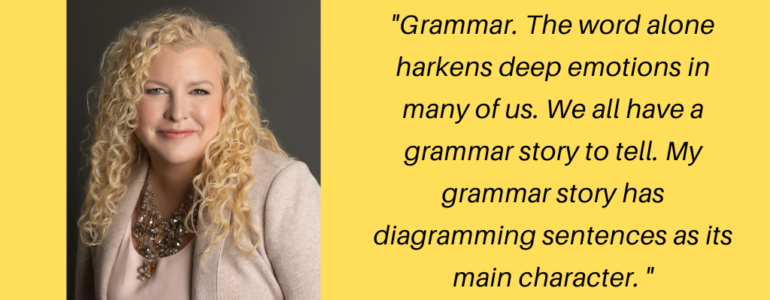By Patty McGee
Grammar. The word alone harkens deep emotions in many of us. We all have a grammar story to tell. My grammar story has diagramming sentences as its main character. Raise your hand if you loved this exercise. I know I sure did! I was stellar at horizontal lines holding the subject and predicate, tagging below on diagonal lines the other parts of speech, the adjective below the subject, the adverb below the predicate, and on down the page with more and more sophisticated usage.
The problem was I had no idea how to transfer that know-how into my actual writing in order to inject it with power, purpose, and craft. My personal experience is indicative of the central core of failed grammar instruction: grammar learning is oftentimes siloed so far away from writing that the leap is just too much for students to make. I offer you five instructional moves to ensure grammar and writing instruction stay up close and personal.
Move #1: Expand the Definition of Grammar
In many cases, grammar is perceived in a prescriptive approach, which includes a set of rules to follow that we learn through identifying parts of speech and sentence types. Instead, let’s redefine grammar in a transformational manner as a set of tools that a writer uses to mold, construct, and shape their writing. I liken grammar to the artist’s paintbrush or the whittler’s blade. The more we know how to use grammar, the more we are able to sculpt our writing to amplify our voice.
Move #2: Teach Grammar in Units of Study
When we give students time to explore a set of related grammar concepts over an extended period of time, we build grammar know-how while creating ample opportunities to use this in their writing. Here are a few tips for creating a grammar unit:
- Remember that a true study gives learners the chance to question, hypothesize, seek answers, experiment, memorize, seek feedback, and reflect. Create 5-10 minute pockets of time, three to five times per week to study grammar. Mix up the time to include a variety of these experiences.
- Go deep with a focus area. For example, spend an entire unit on a sentence study exploring, playing with, and using simple, compound, and complex sentences (I suggest always starting a series of grammar units with a foundational unit on sentences).
- In each unit, follow the research on the three phases of learning which includes surface learning, deep learning, and transfer (Hattie 2008). In phase one, surface learning, study the grammatical concept in mentor texts. Notice how writers use, let’s say, different sentence structures. Then study those sentence structures across time. Practice using those sentence structures with partners. In the last part of the unit, set up time to transfer these new skills into writing. Be sure to revisit these new skills in writing across many text types across the year.
Move #3: Prioritize Usage
The ultimate goal of grammar instruction is for students to use grammar effectively in their writing. Take, for example, this piece from a primary student. I have labeled the way this student used grammar.
Without knowing this student, I am confident that she was probably not saying to herself, “Let me begin this piece using a sentence with correct subject/verb agreement in the simple past tense.” She did, however, do just that! With a focus on usage, students are more likely to incorporate what they are learning into their writing.
Move #4: Teach Grammar Strategically
When students are taught how to strategically use grammar, they are more likely to eventually master those concepts. When teaching strategically, create an anchor chart that includes a step-by-step on how to use the grammar concept in writing. Model in your own writing so learners can envision what each step looks like. It may look like this chart:
Move #5: Build in time to play
Playful grammar? Yes, please! One way to play with grammar is to use Grammar Word Cards. These cards are a collection of different parts of speech, endings, and punctuation. Here’s how to use them:
- After printing out the cards, laminate so they will last for a long time. Then cut the words out. Put in a baggie or envelope.
- Create partnerships or trios of students. Ensure there are enough bags of words for each partnership or trio. So if there are 20 students in your class, be sure to have about 10-word bags.
- Challenge students to use the Grammar Word Cards in different ways. You might say:
- Build a compound sentence
- Build a compound sentence with words in alphabetical order
- Build a simple sentence that is more than ten words long
- Build a few simple sentences. Combine them into a compound sentence. Try to make them into a complex sentence.
Tip! In lieu of correcting students if their attempts are off-base, challenge students to find and correct the error. For example, if there is a comma missing in a compound sentence say, “That is almost a compound sentence. There’s one more thing you need.” Encourage students to problem solve.
These five simple yet powerful instructional moves will have a huge impact on how students use grammar as their artistic tool to mold, construct, and shape their writing.
Go teach grammar brilliantly!
Learn more about Patty McGee- Click here!
![]()













